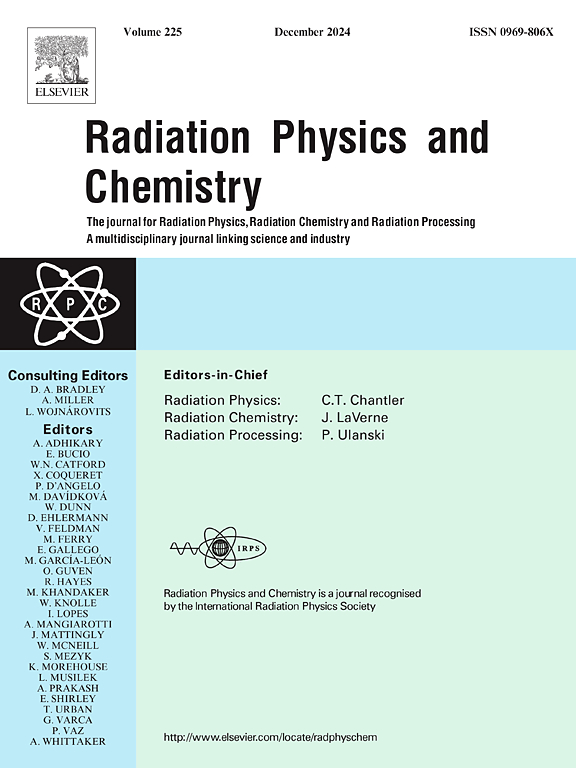High energy electron radiation inducing non-homogeneous structural changes on single layer graphene/SiO2/Si substrate
IF 2.8
3区 物理与天体物理
Q3 CHEMISTRY, PHYSICAL
引用次数: 0
Abstract
Graphene's performance under radiation is crucial for its potential applications in radiation-hardened electronics. In this study, we investigate the physical topology and lattice modification of single layer graphene (SLG) grown on a SiO2/Si substrate when exposed to high energy (MeV) electron radiation. SLG samples, synthesized via chemical vapor deposition (CVD), were irradiated with a 3 MeV electron beam at doses of 50 kGy, 100 kGy, and 200 kGy. Raman microscopy and Field Effect Scanning Electron Microscopy (FESEM) were employed before and after radiation to analyze the microstructural and lattice changes. Our findings reveal that at 200 kGy, certain regions of the sample exhibit G band splitting in the Raman spectra, correlating with FESEM images showing wrinkles, ripples, and folded-like structures. This suggests interactions between surface charges and graphene phonons due to high-energy electron radiation, along with strain-induced lattice distortions in disordered graphene. Interestingly, other regions maintain the sharp shape of G and 2D bands, with a smaller D band peak, indicating minimal structural disorder. The weak defect peak suggests the early stages of amorphization caused by radiation-induced defects. These results highlight the non-homogeneous structural changes in SLG under high energy electron radiation, emphasizing the complex effects of radiation on graphene.
高能电子辐射诱导单层石墨烯/SiO2/Si衬底的非均匀结构变化
石墨烯在辐射下的性能对其在辐射硬化电子产品中的潜在应用至关重要。在这项研究中,我们研究了在SiO2/Si衬底上生长的单层石墨烯(SLG)在高能(MeV)电子辐射下的物理拓扑结构和晶格修饰。通过化学气相沉积(CVD)合成的SLG样品,分别在50、100和200 kGy的剂量下用3 MeV的电子束照射。采用拉曼显微镜和场效应扫描电镜(FESEM)分析辐照前后的微观结构和晶格变化。我们的研究结果表明,在200 kGy时,样品的某些区域在拉曼光谱中表现出G带分裂,与FESEM图像相关,显示出皱纹,波纹和折叠样结构。这表明,由于高能电子辐射,表面电荷和石墨烯声子之间存在相互作用,以及无序石墨烯中应变诱导的晶格扭曲。有趣的是,其他区域保持了G和2D波段的尖锐形状,D波段峰值较小,表明结构紊乱最小。弱缺陷峰表明辐射缺陷引起的非晶化的早期阶段。这些结果突出了高能电子辐射下SLG的非均匀结构变化,强调了辐射对石墨烯的复杂影响。
本文章由计算机程序翻译,如有差异,请以英文原文为准。
求助全文
约1分钟内获得全文
求助全文
来源期刊

Radiation Physics and Chemistry
化学-核科学技术
CiteScore
5.60
自引率
17.20%
发文量
574
审稿时长
12 weeks
期刊介绍:
Radiation Physics and Chemistry is a multidisciplinary journal that provides a medium for publication of substantial and original papers, reviews, and short communications which focus on research and developments involving ionizing radiation in radiation physics, radiation chemistry and radiation processing.
The journal aims to publish papers with significance to an international audience, containing substantial novelty and scientific impact. The Editors reserve the rights to reject, with or without external review, papers that do not meet these criteria. This could include papers that are very similar to previous publications, only with changed target substrates, employed materials, analyzed sites and experimental methods, report results without presenting new insights and/or hypothesis testing, or do not focus on the radiation effects.
 求助内容:
求助内容: 应助结果提醒方式:
应助结果提醒方式:


